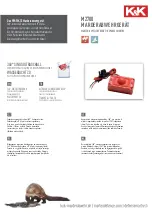
14
d. If there is a problem with high voltage, the controller should
go into the High Voltage Disconnect mode (see section 5.2).
3. L
OAD
N
OT
O
PERATING
P
ROPERLY
a. Check that the load is turned on. Check that no system fuses
are defective. Check that no system circuit breakers are
tripped. Recall that there are no fuses or circuit breakers
inside the ProStar.
b. Check connections to the load, and other controller and
battery connections.
c. Check for proper LED indications on the ProStar. If the red
BATTERY CHARGE
LED is on, the load has been disconnect-
ed due to low battery voltage. This is generally a normal
state when the load exceeds the PV array output due to
weather and sunlight conditions.
d. If all LED indicators are flashing in sequence, the load may
be shorted. Determine the cause of the short, repair the
short circuit, and reset the controller (see section 4.2-6).
e. If the ProStar internal temperature is above 80°C, the load
will be disconnected. All LED’s will be flashing in sequence.
Check to ensure for clear airflow around the ProStar and that
nothing is obstructing the vents at the top of the case.
4. LED I
NDICATORS
A
RE
F
LASHING
I
N
S
EQUENCE
a. The load may have a short-circuit. Refer to section 4.2-6.
b. The controller may have shutdown due to excessive
temperatures. Refer to 3.e above and section 5.2.
c. The controller may have shutdown due to a High Voltage
Disconnect. See section 5.2 and 2.d above.
5. BATTERY CHARGE R
ED
LED I
NDICATOR
F
LASHING
a. This indicates the battery voltage is very low, and the load
may be disconnected soon. Turn off or reduce loads on the
system to allow the battery to recharge. When the battery
capacity increases, the yellow LED indicator will turn on,
followed by the green LED that indicates nearly full charge.
b. If the red LED flashes frequently, the most likely cause is a
load that is too large for the PV array. Another cause is a
defective battery that cannot hold a charge.


































